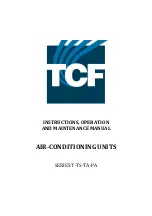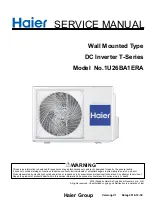
The limit switch, operates when a high temperature
condition, caused by inadequate supply air flow occurs,
thus shutting down the ignition control and closing the main
gas valve.
2. Centrifugal Switch (CS-36). If the draft motor should fail, the
centrifugal switch attached to the shaft of the motor
prevents the ignition control and gas valve from being
energized.
3. Redundant Gas Valve. This valve is an integral part of the
main gas valve and is located up stream of the main gas
valve. Should the main gas valve fail in the open position
the redundant valve serves as a back up and shuts off the
flow of gas.
4. Flame Sensor Rod. This sensor rod is located on the far
side of the carryover tube. If the ignition control does not
receive a signal from the flame sensor indicating that the
pilot flame has ignited properly, the main gas valve will not
open. If the flame sensor fails to detect the pilot flame during
operation of the main burners, a signal is sent to the ignition
control to close the main gas valve.
5. Rollout Switch. This switch is located in the burner
vestibule. In the event of a sustained main burner flame
rollout, it shuts off the ignition control and closes the main
gas valve.
6. Auxiliary Limit Switch. This control is located inside the heat
exchanger compartment and is set to open at 180
°
F. It is a
manual reset switch. If the auxiliary limit switch trips, then
the primary limit switch has not functioned properly.
Replace the primary limit switch.
HEAT ANTICIPATOR SETPOINTS
The anticipator must be set correctly. Too high of a setting will
result in longer heat cycles and a greater temperature swing in
the conditioned space.
Reducing the value below the correct setpoint will give shorter
“ON” cycles and may result in the lowering of the temperature
within the conditioned space.
PRE-START CHECK LIST
Complete the following checks before starting the unit.
1. Check the type of gas being supplied. Be sure that it is the
same as listed on the unit nameplate.
2. Make sure that the vent and combustion air hoods have
been properly installed.
Units
(Tons)
Capacity, MBH
Limit Control
Opens,
°
F
Input
Output
3
4
3
4
5
5
6
6
50
75
100
125
100
125
100
125
40
60
79
99
79
99
79
99
165
165
165
165
165
165
165
165
TABLE 16 - LIMIT CONTROL SETTING
Gas Valve
Anticipator Setpoint
Honeywell VR8204M
0.60 amp
White-Rodgers 36E36
0.54 amp
START-UP
OPERATING INSTRUCTIONS
CAUTION: This furnace is equipped with an intermittent pilot
and automatic re-ignition system. DO NOT attempt
to manually light the pilot.
TO LIGHT PILOT AND MAIN BURNERS:
1. Turn “off” electric power to unit.
2. Turn room thermostat to lowest setting.
3. Turn gas valve knob to “on” position.
4. Turn “on” electric power to unit.
5. Set room thermostat to desired temperature.
(If thermostat “set” temperature is above room temperature,
pilot burner ignition will occur and, after an interval to prove
pilot flame, main burners will ignite).
TO SHUT DOWN:
1. Turn “off” electric power to unit.
2. Depress knob of gas valve while turning to “off” position.
POST-START CHECK LIST (GAS)
After the entire control circuit has been energized and the
heating section is operating, make the following checks:
1. Check for gas leaks in the unit piping as well as the supply piping.
2. Check for correct manifold gas pressures. See “Checking
Gas Input”.
3. Check the supply gas pressure. It must be within the limits
shown on rating nameplate. Supply pressure should be
checked with all gas appliances in the building at full fire.
At no time should the standby gas line pressure exceed 13",
nor the operating pressure drop below 4.5" for natural gas
units. If gas pressure is outside these limits, contact the
local gas utility for corrective action.
MANIFOLD GAS PRESSURE ADJUSTMENT
Small adjustments to the high-fire gas flow may be made by
turning the pressure regulator adjusting screw on the automatic
gas valve. Refer to Figure 9.
Adjust as follows:
1. Remove the cap on the regulator. (High Fire adjusting
screw on valve).
2. To decrease the gas pressure, turn the adjusting screw
counterclockwise.
3. To increase the gas pressure, turn the adjusting screw clockwise.
NOTE: Check the unit dataplate for the proper manifold pres-
sure and orifice size of the furnace.
PILOT ADJ.
(UNDER
SCREW)
“ON”-"OFF"
CONTROL
HIGH FIRE ADJ.
(UNDER SCREW)
Honeywell
VR8204M
“ON”-"OFF" CONTROL
PRESSURE REGULATOR
MANIFOLD ADJUST. SCREW
1/2-14 NPT (OUTLET)
White-Rodgers
36E36
PILOT ADJ.
(UNDER
SCREW)
FIG. 9 - GAS VALVES
530.18-N8W
Unitary Products Group
15






































